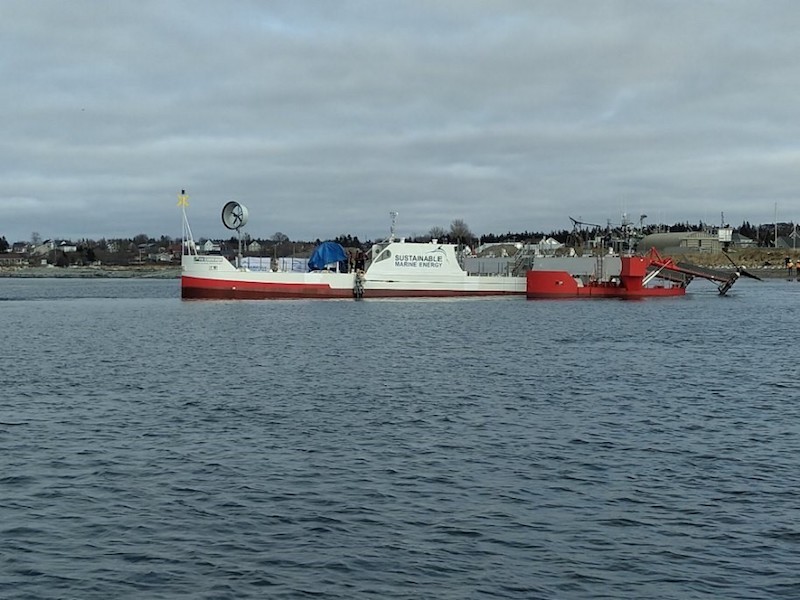Sustainable Marine is forging ahead with plans to deliver the world’s first floating tidal energy array after unveiling its next-generation platform in Nova Scotia, Canada.
Construction of the pioneering new 420 kW PLAT-I 6.40 floating tidal energy platform was recently completed at A.F. Theriault & Son Ltd. in Meteghan, Nova Scotia and launched this week in the Bay of Fundy, which experiences the highest tides on earth.
The new vessel will undergo commissioning and testing in Grand Passage and will then be moved to the FORCE (Fundy Ocean Research Centre for Energy) site as part of the first phase of the ground-breaking Pempa’q In-stream Tidal Energy Project. The Pempa’q Project takes its name from the Mi’kmaq First Nation word “Pempa’q” meaning “rise of the tide”, in honor of the Bay of Fundy’s Indigenous communities.
The total in-stream tidal energy project will deliver up to nine megawatts of electricity to the Nova Scotia grid. This will reduce greenhouse gas emissions by 17,000 tons of carbon dioxide a year and power approximately 3,000 homes in Nova Scotia.
“This tidal technology is the result of a tremendous international effort combining world-class scientific and engineering expertise from our German, Scottish and Canadian teams, and is the culmination of a decade of research and development,” Jason Hayman, Sustainable Marine, CEO, said in a statement announcing the delivery. “We are very fortunate to have such strong support from our major shareholders, Schottel and Scottish Enterprise, the Government of Canada, and a wide range of partners and collaborators. The PLAT-I 6.40 has been designed specifically for the Pempa’q Project — where we will deliver the world’s first floating tidal array — in Nova Scotia, which has the best natural resources in the world to produce clean renewable tidal energy.”
The Pempa’q Instream Tidal Energy project is a ground-breaking initiative and is being supported by the Government of Canada with $28.5 million in funding — one of Canada’s largest-ever investments in tidal energy.
“We are harnessing the power of our tides to power our homes, our businesses and our communities,” said the Honourable Seamus O’Regan Jr., Canada’s Minister of Natural Resources. “This is how we build our clean energy future.”
“The construction and launch of Sustainable Marine’s floating in-stream tidal technology is a significant milestone for Canada’s marine renewable energy sector. The project has engaged many local suppliers and offers a sustainable and clean solution for electricity production using a local resource. Projects and innovation like this are central to building Canada’s Blue Economy,” said Elisa Obermann executive director of Marine Renewables Canada
The PLAT-I 6.40 builds on the lessons learned and experience gained from Sustainable Marine’s previous successful deployments in Scotland and Nova Scotia. It was designed specifically for the FORCE site, and produces 50% more power than its predecessor, the PLAT-I 4.63, which has undergone rigorous testing since 2017, first in Scotland before relocation to Grand Passage, Nova Scotia, in 2018. During testing the system has successfully produced power and has demonstrated it can operate in adverse weather conditions. It is also measuring crucial environmental effects and has not recorded any evidence of adverse impacts on fish or marine animals.
The innovative tidal platform only requires two meters (7'6") of water for launching and towing and is moored with a turret configuration allowing it to align with the tide or the river flow. It has been designed so it’s easy to install and is accessible for maintenance and servicing, addressing one of the key challenges experienced by earlier tidal energy developers.
This new technology was originally developed in Scotland with support from Scottish Enterprise’s WATERS funding, before arriving in Nova Scotia.
“This project highlights the innovation taking place in Scotland around renewable technology. Scottish Enterprise has been proud to support Sustainable Marine as it set up in Edinburgh, developed and tested its tidal solution off the shores of Scotland and will now be deployed in Canada’s first floating tidal energy system to power its communities and contribute to global net zero aspirations,” said Andy McDonald, head of low carbon transition at Scottish Enterprise. “Our investment arm was also very pleased to support the company on behalf of the Scottish Government via its Energy Investment Fund. It’s fantastic news that technology developed in Scotland will deliver environmental benefits across the globe and as COP26 takes place in Glasgow later this year, this is yet another example of Scottish ingenuity and low carbon leadership.”




